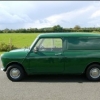I am fitting a dim dip system to my Mini. I am having trouble identifying which terminals are which on the Lucas relay as the terminals are not marked.
Having taken the cover off the relay and inspected the circuitry inside I have worked out the terminals to connect the resistor, and the two dipped headlight (blue/red) wires (from the switch and to the headlights) to, so that's three out of seven.
I have sketched out the circuitry onto paper but it has two transistors with unmarked terminals, two diodes with unmarked polarity and four resistors and I am struggling to understand the current flow in the circuit.
So I need to know which terminals to use for earth (black), fused ignition live (green), sidelights (red), and headlights on (blue).
If someone still running the system could have a look at theirs and even post a picture of the wiring and terminals that would be greatly appreciated.

















